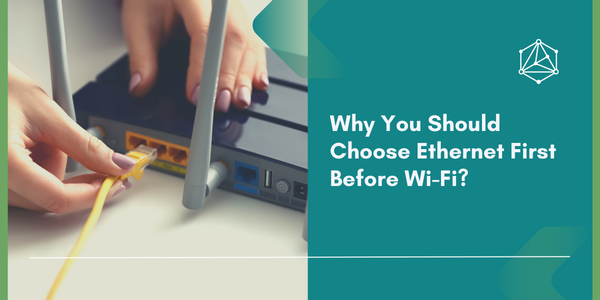In today’s interconnected world, where digital communication and seamless connectivity are critical, the proverbial battle between Ethernet and Wi-Fi continues. As an IT services provider, we often find ourselves addressing this question with our non-profits: “Why would I even need to connect to Ethernet first instead of choosing Wi-Fi, both in the office and for our employees at home?” The answer to this seemingly simple question touches on reasons that speak to reliability, security, speed, and overall network performance.
What Exactly is Ethernet?
When you understand what Ethernet is, why it matters makes more sense. Ethernet is a wired communication standard that was initially designed in the early 1970s. Those original coaxial cables have evolved into lightning-fast fiberoptic, or at worst, twisted paired cables. Most of us have at least some form of ethernet in our homes because our residential gateways connect the cable coming into our homes to our Wi-Fi networks. Often our cable modems will have additional Ethernet ports on them, which allows you to expand your home Ethernet network if you choose. The main advantage of Ethernet is exactly why some people question it – it is a hard-wired system. That gives it some advantages that Wi-Fi – which is essentially a radio signal – can’t match.
Reliability: A Foundation for Seamless Operations
A solid network infrastructure is essential to ensuring that your non-profit employees can function. Ethernet, with its wired connection, offers a steadfast and dependable link between devices and the network. Unlike Wi-Fi, which can be susceptible to interference from various electronic devices, physical obstructions, or other Wi-Fi networks in the vicinity, Ethernet provides a stable connection that remains largely unaffected by external factors.
In a non-profit office environment where productivity is key, a reliable network ensures that employees can work without disruptions, whether they are collaborating on projects, attending virtual meetings, or accessing critical donor data. Similarly, if they take their work home, a stable connection becomes equally crucial for remote work, online meetings, or any type of event streaming.
Speed: The Need for Velocity
Speed is another pivotal factor in favor of Ethernet. With gigabit Ethernet becoming increasingly commonplace, wired connections offer significantly higher data transfer rates compared to most Wi-Fi setups. This becomes particularly crucial in scenarios where large files need to be transferred quickly, or bandwidth-intensive applications are in use.
In a non-profit office setting, where multiple devices are vying for network resources simultaneously, a high-speed Ethernet connection ensures that data flows smoothly, reducing latency and enhancing employee efficiency. When employees are working from home, the demand for speed is equally relevant, especially with the proliferation of smart devices, video conferencing, and bandwidth-hungry applications all feeding off the same residential network.
Security: Guarding Against Digital Threats
Perhaps the best argument for Ethernet is around security. While Wi-Fi networks are typically secured with encryption protocols, they remain more susceptible to various forms of cyber threats, including unauthorized access and data interception. Wired Ethernet, on the other hand, offers a more secure connection that is inherently less vulnerable to hacking attempts.
Particularly in a non-profit where sensitive donor data flows through the network regularly, the added layer of security provided by Ethernet becomes crucial. For remote workers at home, ensuring the safety of confidential information is equally vital. Choosing Ethernet over Wi-Fi mitigates the risk of potential security breaches and safeguards against unauthorized access.
Consistency: Meeting Bandwidth Demands
Today’s applications often demand consistent and reliable bandwidth. Video conferencing, cloud-based collaboration tools, and other bandwidth-intensive applications can strain a Wi-Fi network, leading to dropped connections, lag, and overall diminished performance. Ethernet, with its dedicated and consistent bandwidth, ensures a smooth and uninterrupted experience for users. In an office environment, where teams rely on real-time collaboration tools and video conferencing for effective communication, consistent bandwidth is essential.
Reduced Interference: Steering Clear of Connectivity Hurdles
Wi-Fi networks that operate on radio frequencies are susceptible to interference from various sources, including other electronic devices, neighboring Wi-Fi networks, and physical obstacles. Such interference can lead to signal degradation, packet loss, and decreased network performance. Since Ethernet is a wired connection, it is impervious to these common sources of interference.
In an office setting, where multiple devices and networks must coexist, reducing interference becomes crucial for maintaining a reliable and high-performing network. At home, where the Wi-Fi landscape is often cluttered with numerous neighboring networks, opting for Ethernet ensures a more stable and interference-free connection.
Futureproofing: Embracing Technological Advancements
Planning is critical for non-profits, who often don’t have tremendous amounts of flexibility in their IT budgets. This is challenging because the IT landscape is dynamic. Choosing Ethernet over Wi-Fi provides a certain level of futureproofing for network infrastructures. As newer technologies and higher bandwidth requirements emerge, Ethernet is better equipped to adapt and support these advancements. In an office environment, investing in Ethernet infrastructure ensures that the network can accommodate the evolving needs of the organization without significant overhauls.
Wired Connectivity, the Pillar of Seamless Networking
The choice between Ethernet or Wi-Fi first goes beyond mere convenience; it is a decision that will shape the very foundation of your non-profit’s network infrastructure. As an IT services provider, we advocate for prioritizing Ethernet over Wi-Fi whenever possible, both in the office and at home. The unparalleled reliability, speed, security, and consistent bandwidth offered by Ethernet make it the preferred choice for businesses and individuals alike. Yes, the reality is that non-profits will have devices that use Wi-Fi, but if your primary and essential networks are run via Ethernet, the random Wi-Fi device becomes a much smaller issue.
Is it time for your organization to design a cohesive network infrastructure? Reach out to us at CTD, our non-profit IT solutions experts will create and implement the infrastructure that best suits your needs, saving you time, money, and headaches.

